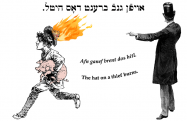(190 results found)
A Gneyve - A Yiddish Song of Theft and Poverty
… the second one is simpler in regards to contour as well as rhythm. Except for the leap of a fourth in the opening … progression. Additionally, except for the cadences, the rhythm of the melodies progresses in eighth notes. The … has a simple melodic structure in a major key with a steady rhythm progression of eighth notes, the second version’s …
The Jerusalem-Sephardic Tradition
… are based on a solo mawal , a musical improvisation in free rhythm, as expressed through the soloist’s personal …

Vals (LKT)
… quadrille, the waltz words were sung which went with the rhythms... Eastern European Jews were accustomed to invite …

Tsepler-tants (LKT)
… springs up in the dance, under the influence of the rhythmic dance-melody? The answer is -- a spontaneous …

Terkish (LKT)
… Tantz...is based on the 1929 accordion solo in terkishe rhythm by Mishka Tsiganoff...(What has been referred to as terkishe rhythm is the same as the Greek sirto dance rhythm.).” Phillips 1996a, p. 19 . (Musical notation and …

Skotshne/Skochne
… the Slavs. He idealizes, as it were, the forms of the Czech rhythm, giving us non-pictorial dances in which rhythm and form are decisive....There are ‘Furiants’, …

Sirba
… triplet motion in the melody performed against a brisk 2/4 rhythm, Jewish sirbas -- especially outside Romania -- do … dance tune typified by triplets in the melody over a 2/4 rhythm.” Alpert 1996b, p. 59 . “The transitional or … differences, both the sirba and the bulgareasca were rhythmically differentiated from the core klezmer dance …

Sher
… -- along with the sherele -- scissors) tends to a more calm rhythm and to graceful expression. The klezmorim knew well … titled ‘shers; were usually medleys of many short tunes. Rhythmically they were performed like freylakhs.” Phillips … because of the clapping accompaniment which forms a counter-rhythm. This line influences the rhythm. Also interesting is …

Shemonah-esreh tants (LKT)
… prayer... The entire prayer was performed in mimicry and in rhythm.” [Brisk, Lithuania, pre-World War II]. Fridhaber …

Polonaise
… [and] the waltz, words were sung which went with the rhythms.” Stutschewsky 1959, pp. 166-67, n. 55 . … Polonaise …




